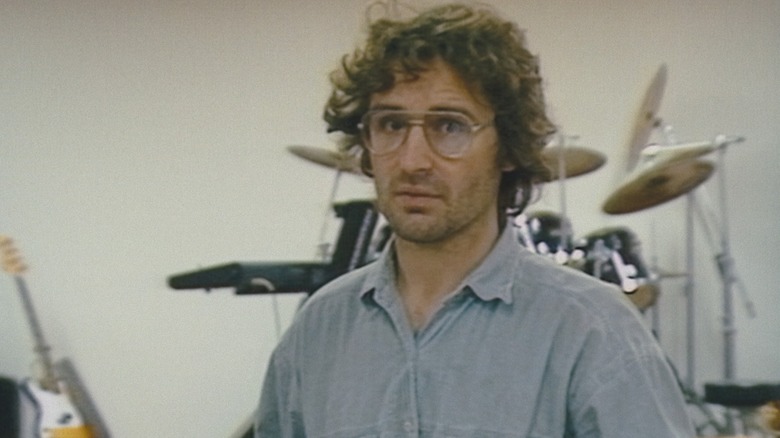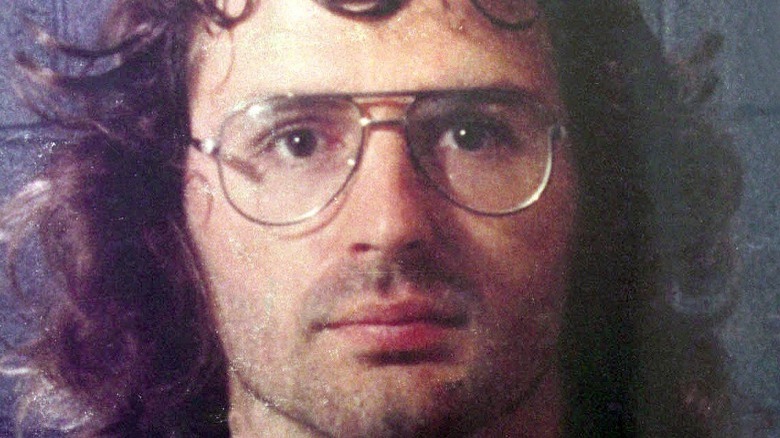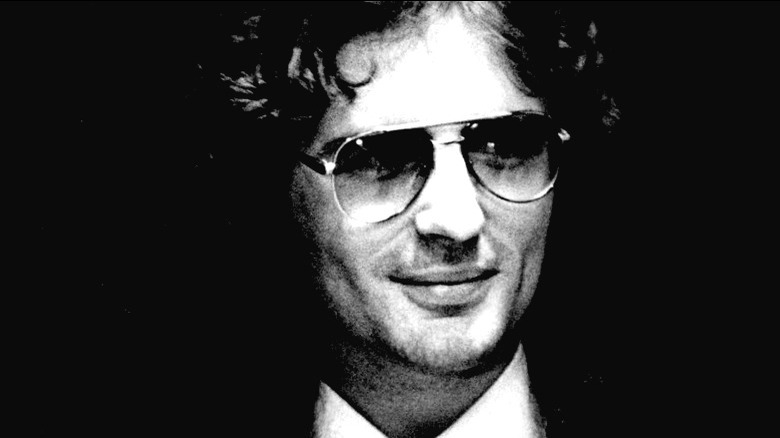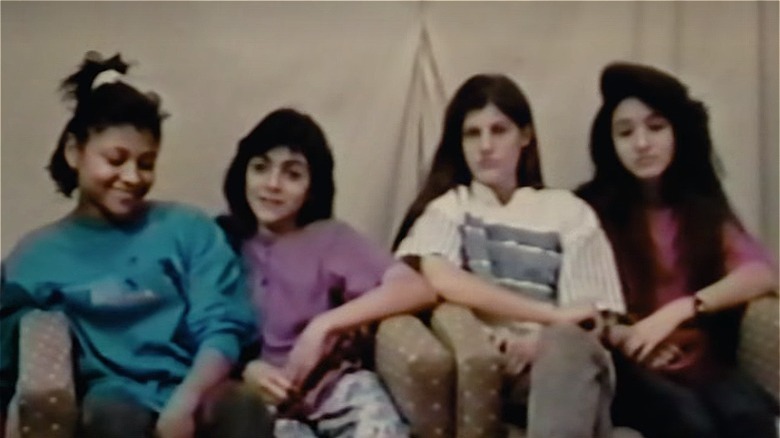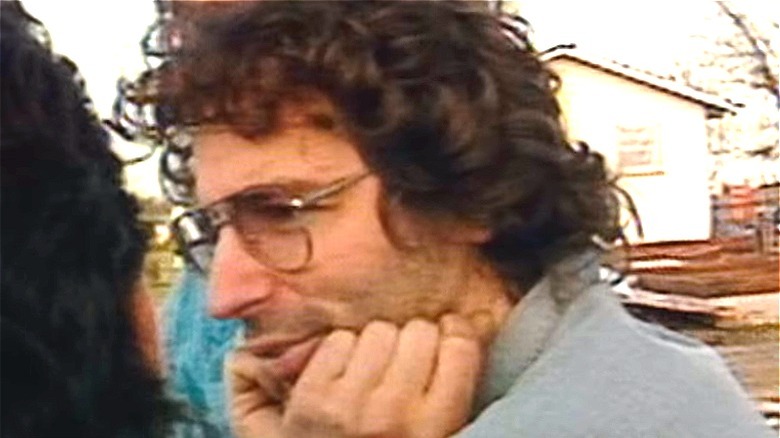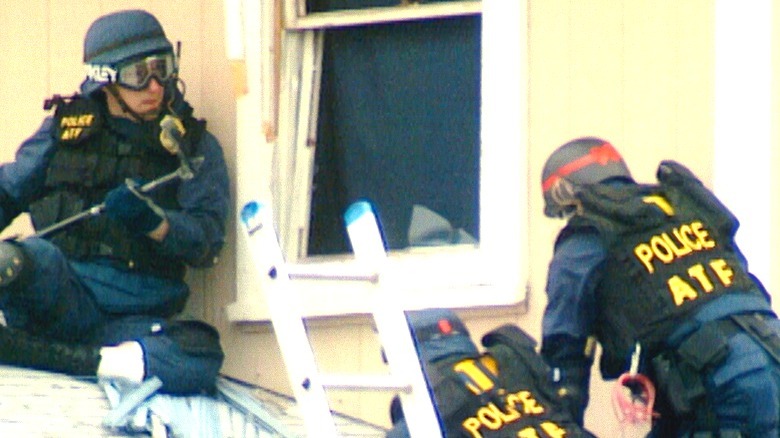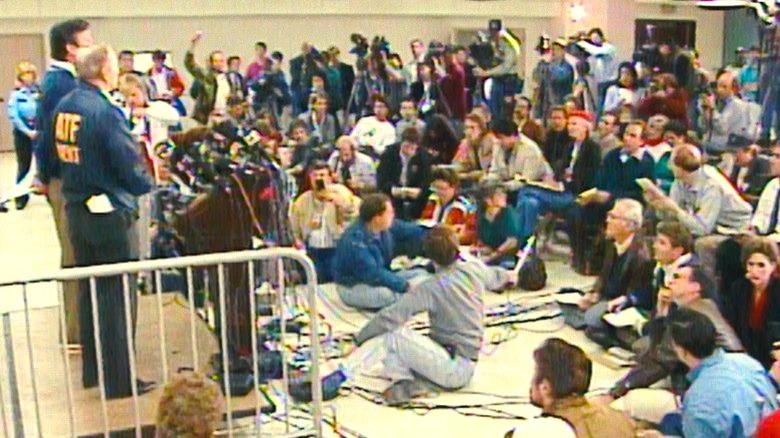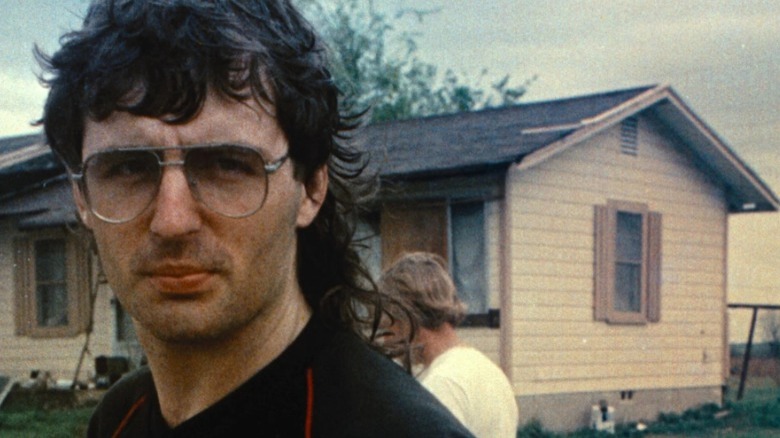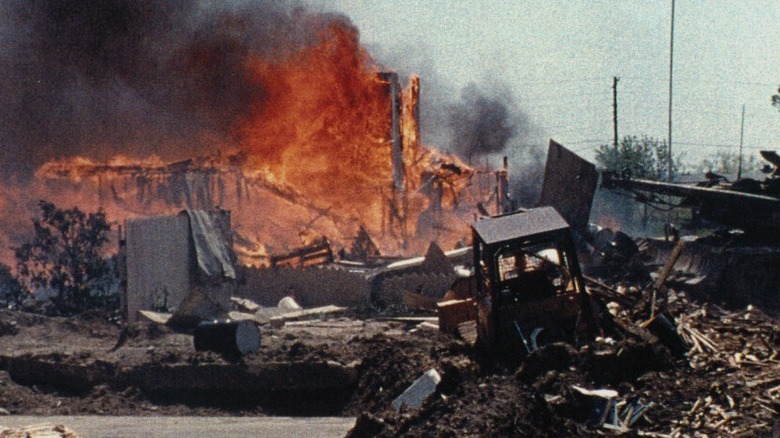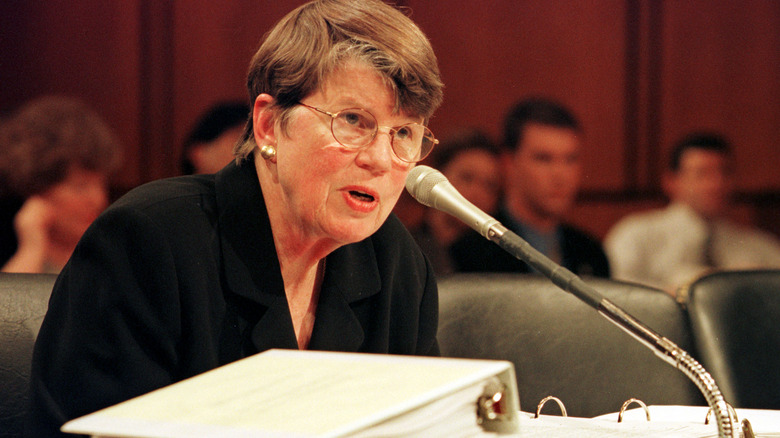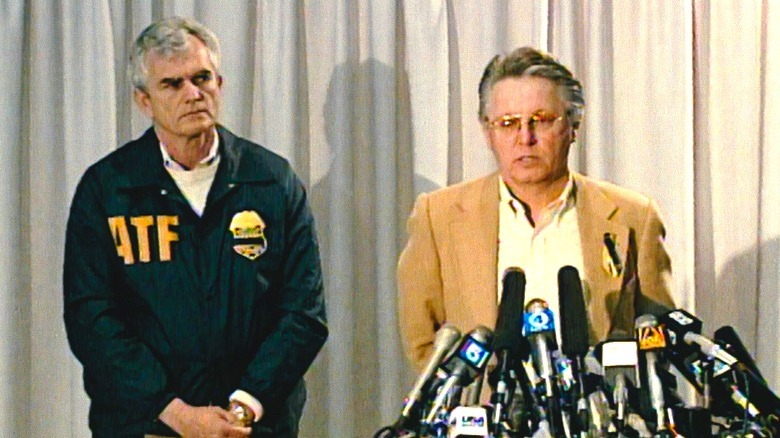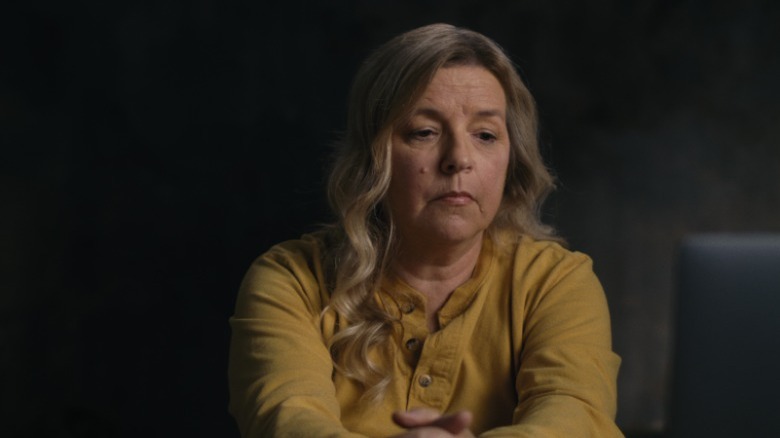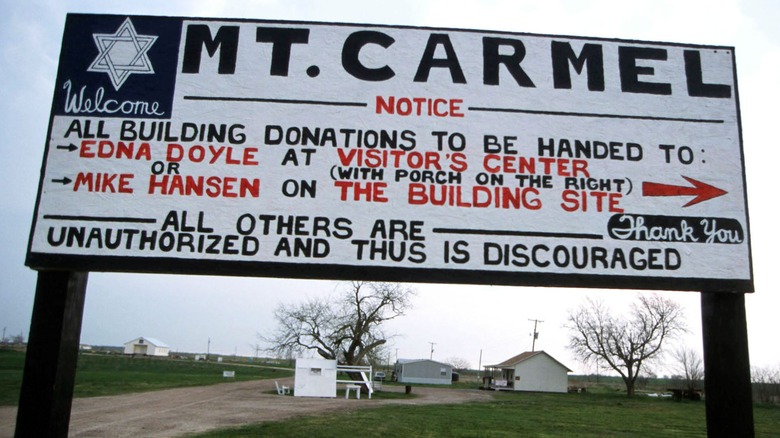Everything Waco: American Apocalypse Didn't Tell You About The True Story
There are thousands of active cults in the United States today, most of them quietly living their lives outside the prying eyes of the world around them. When one of these groups does make the news, it tends to be for the worst reasons, from the ritual suicide of Jonestown and Heaven's Gate to the glitter-dusted Christmas mummy of the Love Has Won cult. But behind these often horrifying news items are the true, deeply heartbreaking experiences of their victims. It's this complexity that Netflix brings to light in the docu-series "Waco: American Apocalypse."
Through candid interviews with survivors on both sides of the conflict and never-before-seen footage, the three-part series aims to bring a more complete picture of the 1993 Waco tragedy, stripping it of easy explanations or handily-laid blame. Emphasizing the lived experiences of everyone involved, the series humanizes the Branch Davidians and the government agents who tried for 51 days to draw them out, ultimately culminating in a deadly fire as the horrified nation looked on. It's a complicated story that began long before the siege and in many ways is still happening today. To fill in the missing pieces, here's everything "Waco: American Apocalypse" didn't have room for.
David Koresh's transition to cult leader was a dramatic one
The notoriously charismatic and manipulative David Koresh would eventually convince his followers that he was the son of God incarnate. Koresh was born Vernon Wayne Howell in 1959 to a 14-year-old mother. Early in his young life, his mother married an abusive ex-convict, adding to his troubled early life. As a dyslexic child, he struggled in school and was mercilessly bullied. But despite these challenges, his mother described him as an inquisitive little boy whose thirst for knowledge led him to dissect everything from truck engines to the Bible — a Bible that he would have memorized in its entirety by the time he was 18 years old.
Former Branch Davidian David Bunds — who first met Koresh in 1981 — described him as a drifter who appeared obviously poor and lost. When he came across the path of the Branch Davidians, a doomsday-focused offshoot of the Seventh Day Adventists, Koresh was a "stuttering, stammering 21-year-old who is barely coherent" – one the Waco Branch Davidians consider "a lost cause," according to writer Jeff Guinn, who penned "Waco: David Koresh, the Branch Davidians, and A Legacy of Rage." But soon, the theologically-gifted Koresh began to gradually position himself as their leader, ultimately becoming the authoritarian prophet who would regulate every aspect of their lives down to where and with whom they slept.
Koresh was involved in a resurrection duel
One story that gets left out of nearly every Waco documentary is the bizarre tale of a resurrection duel that transpired during Koresh's rise to power. As the documentary notes, Koresh's ascension was aided by his relationship with the Branch Davidians' prophet Lois Roden, who was several decades his senior at the time of their affair. When Roden died, leaving a power vacuum, Koresh found himself vying against the late leader's son George for control of the cult. In 1986, George Roden dug up long-buried church member Anna Hughes' corpse for the purpose of challenging Koresh to a "divine test." According to Roden, whoever could resurrect her would be the group's next prophet.
But rather than dabbling in the zombie arts, Koresh, who was living in East Texas with his followers at the time, thought of an easier way to ascend the throne: getting Roden arrested for the desecration of a corpse. When the sheriff told Koresh to produce a photo of the corpse in question, he and eight camo-clad followers conducted what The New York Times described as a "commando-style raid" on the compound that led to the shootout briefly mentioned in "Waco: American Apocalypse." After a mistrial for attempted murder that involved the corpse on full display in court, Koresh ultimately took control of the compound. Roden was later convicted for an unrelated homicide.
Life was miserable for Branch Davidian kids
As portrayed in the series, the Davidians tried to present a picture of go-carts and familial love. Although some abuse is mentioned in the series, all the Waco children suffered immensely. Joann Vaega, who was six years old when she lost both parents in the siege, compared life in Waco to prison. The group lived austere lives without plumbing, electricity, heat, or air conditioning – except for Koresh, who made sure he had air conditioning in the brutal Texas heat — and Koresh dictated every aspect of their lives. Women's appearances were strictly regulated, members attended Bible study three times a day, and food was strictly controlled: processed flour, sugar, and dairy-containing products were off-limits, as were combinations like fruit served with vegetables or apples served with oranges. Doctors were forbidden — former Davidian wife Dana Okimoto eventually left the cult for good after Koresh chastised her for taking her child to the hospital for a broken arm.
For Branch Davidian children, serious discipline began at only six months old. Among the countless miseries Davidian kids were forced to endure were severe beatings from a paddle called "The Helper" and constant verbal humiliation. While girls as young as 11 were sexually abused by Koresh, boys were forced through military drills. One girl was even locked up in a small room and forced to eat from a bowl on the floor for months.
If you or anyone you know has been a victim of sexual assault, help is available. Visit the Rape, Abuse & Incest National Network website or contact RAINN's National Helpline at 1-800-656-HOPE (4673).
A rabbi got him kicked out of Israel
Like any motivated cult leader, Koresh was committed to expanding his fan base, and this meant recruitment trips abroad to Australia, the United Kingdom, and Israel. As millennialists, part of the Branch Davidian belief system is that God will gather his faithful in Israel for the final battle between good and evil. According to religion scholar James D. Tabor, Koresh and his followers believed they would fight beside the people of Israel in this final apocalyptic showdown. It was in Israel that Koresh received an apparent message convincing him that he was the lamb of God and should change his name. To spread the message, Koresh even had business cards made declaring that he was the Messiah.
Israeli Rabbi Avraham Peled encountered Koresh using his guitar busking to attract new followers on an Israel recruiting mission. According to Peled, Koresh would stand on the street singing religious music, then lure new recruits to Mount Carmel with the promise of music-related work and free plane tickets. As a rabbi concerned with cults preying on locals, Peled got to know Koresh and his new recruits with the hopes of turning them away. After dissuading a few of them, Peled reached out to Israel's Minister of Interior to report his concerns. Though the ministry responded by informing Koresh that his visa had expired and it was time to go, he did manage to convert the Argentinian-born Israeli Pablo Cohen, who tragically died in the Waco siege.
The Davidians were training to kill
Far too many sources emphasize the alleged peacefulness of the Branch Davidians or their gun ownership as an investment. While "Waco: American Apocalypse" doesn't play into this mythos, instead clearly outlining the extent of the group's stockpiling and apocalyptic beliefs, the series doesn't quite manage to convey the level of training the group had in anticipation of that apocalypse. Kiri Jewell, who escaped the compound before the Waco siege after her father won custody from her mother, told ABC, "He always said that 'they' would come for us and we were gonna defend ourselves and we were all gonna die."
According to Jewell, the children were raised to believe this so firmly that she was convinced she wouldn't live past the age of 12. As fellow survivor Dana Okimoto put it, "This was war we were preparing for." In the Branch Davidian belief system, the federal government and the outside world were prophesied agents of Babylon – an evil force bent on destroying true believers and their Messiah. Everyone who lived in the compound had been trained for the prophesied warfare, even the elderly women in the group, and the neighbors often reported hearing gunshots coming from Mount Carmel. Despite their training and belief that death would be necessary, many were not prepared for the reality of this commitment. As Jeff Guinn observed on NPR, "They had never really considered, I think, that dying for God involved agony."
The scale of the Waco operation was unprecedented
Despite the Netflix documentary's best efforts to capture the scope of the Waco siege by introducing it as "the largest gunfight on American soil since the Civil War," it's still difficult to impart the sheer scale of the operation from the government side. After the initial ATF and FBI raid expanded, the siege would grow to involve the Texas National Guard, the Texas Rangers, the Department of Public Safety, the McClendon County Sheriff's department, Waco police, and U.S. customs, among other parties. The total complement would include two Black Hawk helicopters, two Bell UH-1 Iroquois helicopters, as many as 10 Bradley fighting infantry vehicles (BFV), two Abrams battle tanks, one Britton-Norman Defender airplane, and hundreds of personnel including federal agents, sheriffs, police, and National Guardsmen.
FBI lead negotiator Byron Sage would later say the operation should have been shut down, a sentiment echoed in a 1993 U.S. Treasury report. As Sage noted, the large military presence likely only served to strengthen the Davidians' unity and resolve. As portrayed in the series, the size and conflicting motivations of these organizations led to internal conflict during the siege as well as some of the more controversial actions taken. Many of these actions escalated tensions with the Davidians, with survivors later recalling Bradleys running over a freshly-dug grave and agents shooting the Branch Davidians' dogs.
Koresh played retaliation music during the seige
During the 1970s, Koresh was interested in playing rock music. As he became more involved in religion, he never abandoned his love of music. Koresh even named one of his guitars the "Psalms 45 guitar," comparing it to the Song of Solomon, the steamiest book in the Old Testament. According to Clive Doyle, one of the few Branch Davidians to survive the siege, music was one of the tools Koresh used to bring in new followers. In 1994, a former acquaintance of Koresh produced an album of his music titled "Voice of Fire." Today, remastered versions of the music David Koresh wrote can be found lurking around online. And despite the Davidians' many personal prohibitions, the congregation shared a pretty sweet setup in the main chapel including recording equipment and an extensive collection of instruments.
In their efforts to force the Davidians out, the FBI began blasting a playlist of strange sounds and music that included animal noises, reveille, ringing phones, Tibetan chants, Christmas carols, and Nancy Sinatra. In an almost comical moment in an otherwise dark tale, Koresh and his pals hit back with their own sweet sounds. As hostage negotiator R. J. Craig would later recall, "He had his little band in there and, all of a sudden, he starts playing." According to Craig, the impromptu battle of the bands lasted for hours.
Arson investigators later concluded the Davidians started the fire
The nature of the fire that burned down the Mount Carmel compound has been the subject of countless conspiracy theories in the years to follow, with many conspiracy theorists claiming the U.S. government intentionally set fire to the compound, possibly using tanks mounted with flamethrowers to do it. And then there's the slightly less nefarious theory that the tear gas canisters used in the final push might have interacted with the Davidians' gas lanterns to create fires all over the complex. Contradicting these claims, the pyrotechnic canisters used in the operation were fired six hours before the blazes started, and as emphasized in the Netflix documentary, though, no Davidians fled the building when these fires erupted.
A panel of arson investigators later concluded that the Davidians started three fires across the compound based partly on the fact that the fires were started simultaneously and accelerants like lighter fluid were detected in the aftermath. Surviving cult member Clive Doyle, who tearfully claimed the Davidians did not start the fires, was found wearing a jacket soaked in accelerant. Several of the children's bodies recovered were also found to have died from gunshots and a stabbing. Due to the fire, these children were unreachable during the compound's final moments and would have been killed by their parents or other Branch Davidians — further evidence that the adult cultists chose death by suicide.
Janet Reno's response was much more nuanced than portrayed in the documentary
One of the more controversial aspects of the Waco siege centers around Attorney General Janet Reno's involvement. As recounted in the Netflix series, Reno had recently been sworn in, making Waco one of the first major tests she would face in office. When it became clear that Koresh had no intention to surrender, FBI HRT commander Dick Rogers flew to Washington to meet with Reno and make the case for tear gas use.
In the final episode, Journalist Lee Hancock emphasized what Rogers chose to reveal to Reno during this briefing. According to Hancock, Rogers showed Reno claims of child abuse from former Davidians but omitted the video recorded during the siege that showed Koresh and the children currently in the compound because they "made Koresh look pretty good." This idea that Reno unilaterally ordered tear gas in response to exaggerated abuse claims was a common sentiment in the Waco aftermath, but it grossly oversimplifies Reno's decision.
Although the Justice Department report would later say there wasn't explicit evidence children at the compound were being physically or sexually abused, the report also concluded that the FBI did not exaggerate the claims that were presented or "sell" the idea of tear gas to Reno. Instead, she and her advisors considered a number of complex issues including the rapidly deteriorating conditions inside the compound while weighing the possible outcomes of tear gas use and other options. Tragically, she wasn't briefed on the Davidians' commitment to die rather than surrender.
The FBI and ATF made significant changes because of Waco
Based on his doomsday prophecies and the previous shootout at Mount Carmel, it was likely only a matter of time before David Koresh brought violence upon his followers. Nonetheless, the long string of mistakes and miscalculations made by federal and local officials made the final bloodbath a foregone conclusion. Reflecting on these events in a Reason interview, series director Tiller Russell emphasized that the FBI was dealing with a "completely new scenario in terms of scale, intensity, and duration." Under such circumstances, the potential for serious mistakes to be made is significant.
Fortunately, those mistakes led to serious reforms in both the ATF and FBI. Agent Byron Sage cited poor communication between the tactical and hostage negotiation teams as one of the key problems during the Waco siege. It's something they've worked to correct moving forward. The ATF has also standardized its training across special response teams while expanding its instruction in warrant execution, hostage management, and several other areas. Likewise, the FBI has worked to increase training and cohesion. Today, it trains hostage negotiation and tactical units together, and the organization has established a Critical Incident Response Group for overseeing these operations. As FBI Chief of the Tactical Section and Commander of the Hostage Rescue Team David Sundberg emphasizes, the need for a unified response is more important now than ever in light of the recent increase in mass shootings and other critical incidents.
The cult still exists today
Just as several surviving members of the Heaven's Gate cult are still out there spreading Marshall Applewhite's message long after their fellow acolytes exited the earthly plane, David Koresh still has a small handful of believers despite their apocalypse coming and going. Kathy Schroeder, who narrowly survived the final showdown by getting arrested when she came out to see her son, made no effort to hide her enduring loyalty to Koresh in her appearance in the Netflix series. In the documentary, she provides a jarring glimpse into the Davidians' twisted worldview while describing sex with Koresh as a religious experience and insisting that Koresh wasn't a pedophile because his victims were adults in their belief system.
Resurrection is a key part of the Davidians' belief system, and it's something that survivors who lost loved ones in the siege cling to. Some of the surviving devout believe that Koresh – along with everyone else who died at Waco — are currently in a state of "soul sleep" and will be resurrected during the Ceremonial Harvest. Along with fellow survivor Clive Doyle, who died in 2022, Sheila Martin kept the faith alive in Waco, believing they would be reunited with their families one day. Speaking to CNN in 2011 true believer Sheila Martin, who lost her husband and four of their children in the fire, proclaimed, "David is the messiah, and he's coming back."
The Waco compound is open to the public
The story of the Waco compound dates back to 1929, when Victor Houteff was disfellowshipped from the Seventh-Day Adventists for heresy and traveled to Texas, where he formed the Davidians, also known as the Shepherd's Rod or simply "The Rod." When he died, his wife Florence took over, purchasing the 941-acre New Mount Carmel property in Waco in 1957.
By the time Koresh took over in 1987, the compound looked "more like an armed camp than a religious retreat," according to local news station Fox 5. Today, the site is the home of a Davidian offshoot founded by Charles Pace, a man Koresh considered a blasphemer. Speaking to the Associated Press, Pace called the Waco tragedy "an object lesson" orchestrated by God "to show how crazy church leaders can be." The ministry, renamed The Lord Our Righteousness, also serves as a memorial for those who died in the Waco siege and has become a pilgrimage site for anti-government Christian nationalists and conspiracy theorists. In 1994, survivors lined the drive with a crepe myrtle for each of the 82 Branch Davidians who lost their lives at Waco, although Pace would cut down the one dedicated to Koresh, whom he deemed a false prophet.
But if you're planning to visit the site, don't expect a tame sermon. Instead of a doomsday message, Pace puts his energy into preaching absurd conspiracy theories about the Deep State.
